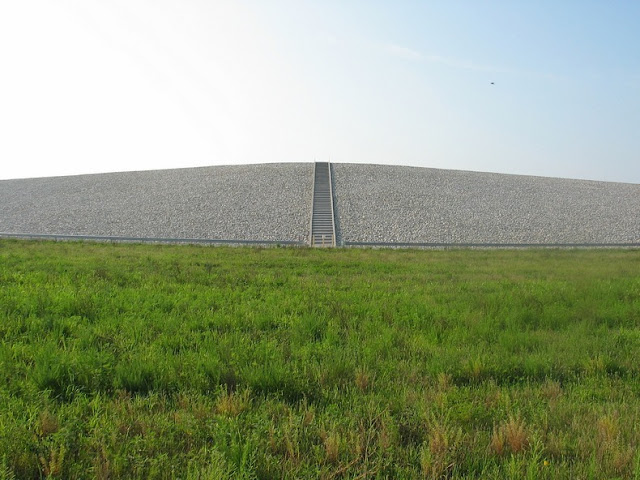In Saint Charles County, Missouri, near Weldon Spring, adjacent to Highway 40, lies an enormous mound of rocks, rising out of the ground like an ancient burial tomb. Underneath it lies tons of hazardous waste produced by a chemical plant that once stood in its place. Today, Weldon Spring draws thousands of curious visitors each year. They climb to the top of the 75-foot tall dome to read the placards that tell the story of the sad history of communities that disappeared in 1940 to make way for the world’s largest explosives factory.
Between 1940 and 1941, the US Army purchased over 17,000 acres of land in Saint Charles County, just outside of St. Louis On those land happened to sit three pretty towns with rolling wooded hills - Hamburg, Howell, and Toonerville. They were immediately evacuated. Hundreds of homes, businesses, churches, schools and any other buildings in the area were either demolished or burned and within a few months the three towns ceased to exist. A massive factory was erected to manufacture TNT and DNT in order to supply Allied troops in the Word War II. The Weldon Spring Ordnance Works, operated by Atlas Powder Company, employed more than 5,000 people and contained more than 1,000 buildings. By the time the plant ceased production on Aug. 15, 1945, the day the Japanese surrendered, it had produced more than 700 million pounds of TNT.
After the war the Army began selling off pieces of the land. The State of Missouri acquired 7,000 acres, while the University of Missouri bought another 8,000 acres, which was later sold to the Conservation Department. These pieces of property are today the Busch Memorial Conservation Area and the Weldon Spring Conservation Area.
A small patch of land – about 2,000 acres - was retained by the United States Atomic Energy Commission. It was there the Commission built a uranium ore processing plant in 1955. The Weldon Spring Uranium Feed Mill Plant, operated by Mallinckrodt Chemical Works of St. Louis, processed raw uranium ore into “yellow cake,” or concentrated ore which was shipped to other sites.
The processing plant operated until 1966. During the Vietnam War the Army planned to use part of the old uranium processing facilities to produce Agent Orange, a herbicide used to defoliate jungle during the war. The Army later abandoned the plan without ever producing the chemical at Weldon Spring. The site sat abandoned for more than 20 years, but still contained contaminated equipment and hazardous chemicals. Waste lagoons were filled with thousands of gallons of water contaminated with radioactive wastes and heavy industrial metals.
Beginning in the 1980's, the U.S. Department of Energy began extensive decontamination of the area, eventually building a gigantic waste disposal cell to entomb the waste materials. The official name of this site is the Weldon Spring Site Remedial Action Project (WSSRAP).
Completed in 2001, the mountainous structure covers 45 acres and stores 1.5 million cubic yards of hazardous material. Stairs lead up to the top of the cell where there is a viewing platform and plaques that provide information about the local area, the history of the site, and the construction of the waste disposal cell. Visitors can also visit the 9,000-square-foot interpretive center housed in a building at the base of the cell that was once used to check workers for radioactivity. Incidentally, the top of the Weldon Spring waste disposal cell is the highest point in St. Charles County.
There is a similar nuclear waste dome in on Enewetak Atoll
Sources






















0 comments:
Post a Comment